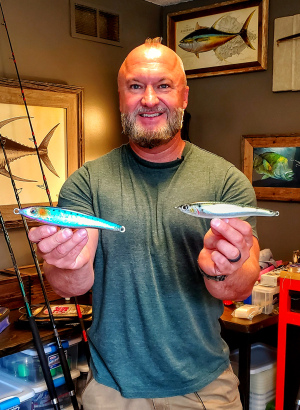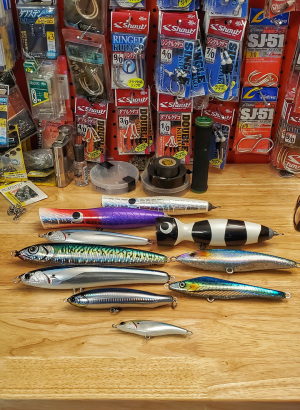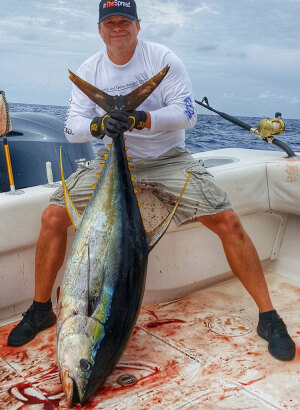In The Spread, a sport fishing educational video company, offers saltwater fishing videos for fishermen to improve their skills and knowledge in catching yellowfin tuna. The videos feature expert fishermen sharing their insights on how to catch various fish species, including tuna, and provide valuable information for anglers looking to enhance their tuna fishing experience.
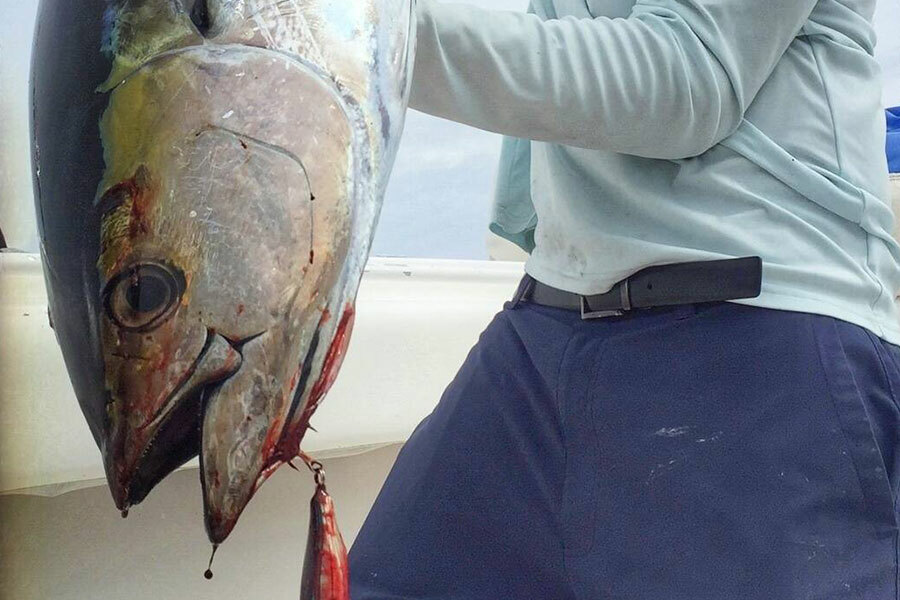
Tuna Fishing – Yellowfin Tuna Lures
Lure Fishing Skills Are a Must
Offshore fishing for yellowfin tuna with lures is an exhilarating and challenging pursuit that requires skill, knowledge, and patience. Yellowfin tuna are known for their incredible speed, power, and endurance, making them one of the most sought-after game fish in the world. To successfully target these magnificent creatures, anglers must have a deep understanding of their behavior, habitat, and feeding patterns, as well as the right gear and techniques to entice them to strike.
One of the most effective ways to catch yellowfin tuna is by using artificial lures, which mimic the appearance and movement of their natural prey. There are many different types of lures that can be used for tuna fishing, including poppers, jigs, and trolling lures, each designed for specific conditions and situations. Poppers, for example, are great for surface feeding tuna, as they create a loud, splashing action that attracts the fish's attention. Jigs, on the other hand, are ideal for deeper water, as they can be fished at various depths and speeds to trigger strikes from suspended fish.
To maximize their chances of success, tuna fishermen must also be proficient in a variety of techniques, such as casting, jigging, and trolling. Casting involves throwing the lure out and retrieving it in a manner that mimics the movement of a fleeing baitfish, while jigging involves dropping the lure to the desired depth and working it up and down in a vertical motion. Trolling, meanwhile, involves dragging the lure behind a moving boat, allowing it to swim through the water column and attract the attention of nearby tuna.
Of course, even with the right lures and techniques, catching yellowfin tuna is no easy feat. These fish are incredibly smart and wary, and they can quickly become wise to the presence of fishermen and their gear. To outsmart them, anglers must be patient, persistent, and willing to experiment with different approaches until they find what works best.
Thankfully, for those looking to improve their tuna fishing skills, there are resources available that can help. In The Spread Saltwater Fishing Videos, for example, offers a wealth of instructional content from some of the world's most experienced and knowledgeable fishermen. Through these videos, anglers can learn about the latest lures, techniques, and strategies for targeting yellowfin tuna and other game fish, as well as gain valuable insights into the behavior and habits of these incredible creatures.
Whether you're a seasoned pro or a novice angler, offshore fishing for yellowfin tuna with lures is an experience like no other. With the right knowledge, gear, and mindset, you too can experience the thrill of the chase and the satisfaction of landing one of these magnificent fish. So why wait? Grab your rods, reels, and lures, and head out to the open ocean in search of your next big catch. With a little luck and a lot of skill, you might just find yourself face-to-face with a majestic yellowfin tuna, ready to do battle and create memories that will last a lifetime.
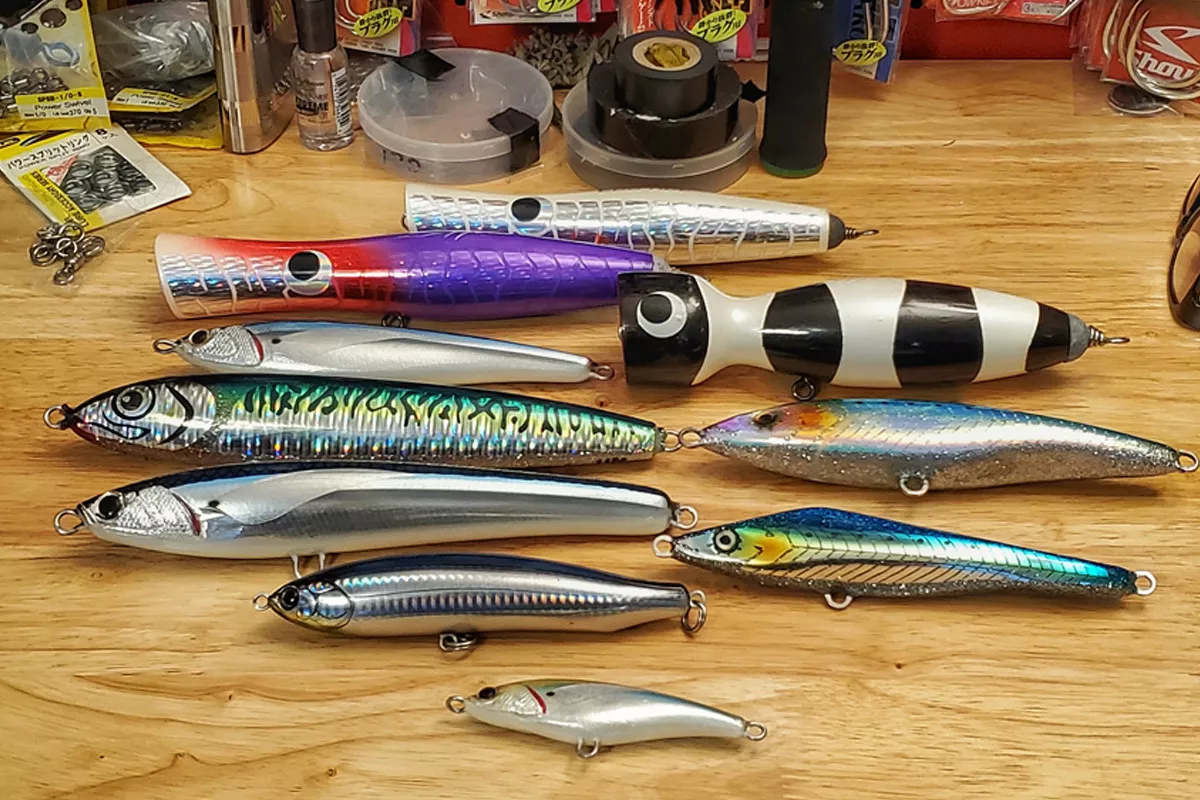
Lures for Tuna Fishing
As any seasoned angler knows, choosing the right lure is crucial for a successful day of tuna fishing. There are several types of lures that can be effective for catching tuna, including casting, trolling, topwater, and jigging lures. Each type of lure has its unique characteristics and can be effective in different conditions.
When it comes to catching yellowfin tuna, the best lures are those that closely resemble the prey they feed on, such as squid, flying fish or small baitfish. The size and color of the lure also play a critical role in attracting these fish. Anglers should choose lures that match the size of the fish they are targeting and vary the color based on the time of day and water conditions.
Many anglers swear by using sub-surface lures, such as sinking stickbaits, for yellowfin tuna. These lures imitate the movement of wounded or dying baitfish and can be fished at varying depths to mimic the behavior of the tuna's prey. Topwater lures, on the other hand, are designed to float on the water's surface and create a commotion that attracts tuna. Anglers often use these lures in calm water or when the fish are feeding near the surface.
Jigs are also popular for yellowfin tuna fishing. These lures are designed to imitate the movement of baitfish, and anglers can use them to target tuna at different depths. Anglers can use different jigging techniques, such as speed jigging or slow pitch jigging, to create an enticing movement that attracts the fish.
One of the most critical aspects of tuna fishing is selecting the right hook and hook size. Anglers should choose hooks that are strong enough to handle the size of the fish they are targeting and select the right size based on the lure and bait being used. For more context, read hooks for tuna fishing.
So what color attracts tuna? The answer depends on the time of day and water conditions. In clear water, blue and green lures can be effective, while in murkier water, orange and red lures may be more visible to the fish. The best time of day for tuna fishing can vary based on the location and species being targeted, but early morning and late afternoon are typically the most productive.
In The Spread offers a variety of instructional videos on the best lures for yellowfin tuna, including Sub Surface Lures For Yellowfin Tuna Fishing, Topwater Lures For Yellowfin Tuna With Seth Hartwick, Jigs For Yellowfin Tuna Fishing | Seth Hartwick and Top 5 Surface Lures for Yellowfin Tuna. These videos provide invaluable insight into the different types of lures and techniques used to catch these elusive fish.
Tuna Fishing Techniques and Tackle
Different tuna species require different fishing techniques. For instance, trolling is a popular technique for catching tuna, as it allows anglers to cover a lot of ground and increase their chances of finding fish. Trolling involves towing lures or bait behind a moving boat at a specific depth and speed to attract tuna.
On the other hand, speed jigging is a technique that involves quickly retrieving a heavy jig vertically through the water column, mimicking an injured or fleeing baitfish. This technique is particularly effective for targeting larger species of tuna, such as bluefin tuna. In Seth Hartwick's "Jigs For Yellowfin Tuna Fishing" video, he shares his expertise on using jigs to catch yellowfin tuna.
Casting is another technique used to target tuna, particularly when fishing in shallower waters. Anglers can cast lures or bait towards areas where tuna are known to be feeding, such as around floating debris or structure. Seth Hartwick's "Topwater Lures For Yellowfin Tuna" and "Best Surface Yellowfin Tuna Lures" videos provide valuable information on using topwater lures and casting techniques to target yellowfin tuna.
When it comes to the question of how far out to go when tuna fishing, the answer depends on several factors, including the species of tuna being targeted and the location of the fishing grounds. Yellowfin tuna can be found in a range of depths, from shallow water to deeper offshore areas, while bluefin tuna are typically found in deeper waters. Whether to anchor or not is also a consideration when tuna fishing, as some anglers prefer to drift with the current while others prefer to anchor and chum to attract fish.
Selecting the right rods and reels is essential when tuna fishing. Anglers typically use heavier rods and reels capable of handling the weight and power of tuna. A 2-speed reel is often preferred for jigging, as it allows for quick retrieval when needed. In addition to selecting the right rods and reels, it's important to use the right line for trolling, such as a braided line, and to ensure that tuna lures are rigged correctly and used in a trolling spread for maximum effectiveness. While spinning reels can be used for tuna fishing, they may not be the best option for targeting larger species of tuna. It all comes down to preference, really.
Remember, catching tuna requires the use of the right lures and techniques. Different types of lures such as casting, trolling, topwater, and jigging lures are all good options to catch tuna. Be prepared with an assortment of tackle and lures, so you can match the feeding behavior of the tuna. The best lures for yellowfin tuna vary depending on the size and color chosen. Speed jigging, casting, and trolling are some of the techniques that can be used to catch tuna. The size and type of rods and reels needed for tuna fishing, including 2-speed reels for jigging, depend on the type of technique used. Rigging tuna lures and using a trolling spread are important techniques that can increase the chances of catching tuna.
In The Spread Tuna Fishing Videos provide an array of information on, not just tuna lures, but tuna fishing in general, so you are able to ramp up your tactical and technical fishing knowledge before hitting the water. The last thing you want to do is experiment while out on the water. It all comes down to time and money. Get the practical expertise to make every fishing moment count.


